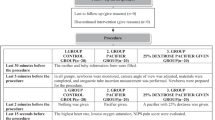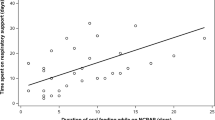Abstract
Objective:
For the premature infant, extrauterine life is a pathological condition, which greatly amplifies the challenges to the brain in establishing functional oromotor behaviors. The extent to which suck can be entrained using a synthetically patterned orocutaneous input to promote its development in preterm infants who manifest chronic lung disease (CLD) is unknown. The objective of this study was to evaluate the effects of a frequency-modulated (FM) orocutaneous pulse train delivered through a pneumatically charged pacifier capable of enhancing non-nutritive suck (NNS) activity in tube-fed premature infants.
Study Design:
A randomized trial to evaluate the efficacy of pneumatic orocutaneous stimulation 3 × per day on NNS development and length of stay (LOS) in the neonatal intensive care unit among 160 newborn infants distributed among three sub-populations, including healthy preterm infants, respiratory distress syndrome (RDS) and CLD. Study infants received a regimen of orocutaneous pulse trains through a PULSED pressurized silicone pacifier or a SHAM control (blind pacifier) during gavage feeds for up to 10 days.
Result:
Mixed modeling, adjusted for the infant’s gender, gestational age, postmenstrual age and birth weight, was used to handle interdependency among repeated measures within subjects. A significant main effect for stimulation mode (SHAM pacifier vs PULSED orosensory) was found among preterm infants for NNS bursts per min (P=0.003), NNS events per min (P=0.033) and for total oral compressions per min (NNS+nonNNS) (P=0.016). Pairwise comparison of adjusted means using Bonferroni adjustment indicated RDS and CLD infants showed the most significant gains on these NNS performance indices. CLD infants in the treatment group showed significantly shorter LOS by an average of 2.5 days.
Conclusion:
FM PULSED orocutaneous pulse train stimuli delivered through a silicone pacifier are effective in facilitating NNS burst development in tube-fed RDS and CLD preterm infants, with an added benefit of reduced LOS for CLD infants.
This is a preview of subscription content, access via your institution
Access options
Subscribe to this journal
Receive 12 print issues and online access
$259.00 per year
only $21.58 per issue
Buy this article
- Purchase on Springer Link
- Instant access to full article PDF
Prices may be subject to local taxes which are calculated during checkout






Similar content being viewed by others
References
Lau C . Oral feeding in the preterm infant. Neoreviews 2006; 7: 19–27.
Hack M, Estabrook MM, Robertson SS . Development of sucking rhythm in preterm infants. Early Hum Dev 1985; 11: 133–140.
Mizuno K, Ueda A . Neonatal feeding performance as a predictor of neurodevelopmental outcome at 18 months. Dev Med Child Neurol 2005; 47: 299–304.
Medoff-Cooper B, Shults J, Kaplan J . Sucking behavior of preterm neonates as a predictor of developmental outcomes. J Dev Behav Pediatrics 2009; 30: 16–22.
DiPietro JA, Cusson RM, Caughy MO, Fox NA . Behavioral and physiologic effects of nonnutritive sucking during gavage feeding in preterm infants. Pediatr Res 1994; 36: 207–214.
Gill NE, Behnke M, Conlon M, Anderson GC . Nonnutritive sucking modulates behavioral state for preterm infants before feeding. Scand J Caring Sci 1992; 6: 3–7.
Pickler RH, Frankel HB, Walsh KM, Thompson NM . Effects of nonnutritive sucking on behavioral organization and feeding performance in preterm infants. Nurs Res 1996; 45: 135.
Pickler RH, Higgins KE, Crummette BD . The effect of nonnutritive sucking on bottlefeeding stress in preterm infants. J Obstet Gynecol Neonatal Nurs 1993; 22: 230–234.
Field T . Sucking for stress reduction, growth and development during infancy. Pediatric Basics 1993; 64: 13–16.
McCain GC . Promotion of preterm infant nipple feeding with nonnutritive sucking. J Pediatr Nurs 1995; 10: 3–8.
Pinelli J, Symington AJ . Non-nutritive sucking for promoting physiologic stability and nutrition in preterm infants. The Cochrane Collaboration, John Wiley & Sons. The Cochrane Library 2010; 6: 1–34.
Boiron M, Da Nobrega L, Roux S, Nenrot A, Saliba E . Effects of oral stimulation and oral support on non-nutritive sucking and feeding performance in preterm infants. Dev Med Child Neurol 2007; 49: 439–444.
Harding C . An evaluation of the benefits of non-nutritive sucking for premature infants as described in the literature. Arch Dis Child 2009; 94: 636–640.
Pickler RH, Reyna B . Effects of non-nutritive sucking on nutritive sucking, breathing, and behavior during bottle feedings of preterm infants. Adv Neonatal Care 2004; 4: 226–234.
Rocha AD, Moreira MEL, Pimenta HP, Ramos JRM, Lucena SL . A randomized study of the efficacy of sensory-motor-oral stimulation and non-nutritive sucking in very low birth weight infant. Early Hum Dev 2007; 83: 385–388.
Bingham P, Ashikaga T, Abbasi S . Prospective study of non-nutritive sucking and feeding skills in premature infants. Arch Dis Child Fetal Neonatal Ed 2010; 95: F194–F200.
Als H . A manual for naturalistic observation of the newborn (preterm and full term infants) In: Goldson E (ed) Nurturing the Premature Infant, Developmental Interventions in the Neonatal Intensive Care Nursery. Oxford University Press: New York, NY, USA, 1995 pp 77–85.
SAS Institute. SAS/STAT 9.2 User's Guide. SAS Institute: Cary, NC, USA, 2002-2012.
Penn AA, Shatz CJ . Brain waves and brain wiring: the role of endogenous and sensory-driven neural activity in development. Pediatr Res 1999; 45: 447–458.
Limperopoulos C, Gauvreau KK, O’Leary H, Moore M, Bassan H, Eichenwald EC et al. Cerebral hemodynamic changes during intensive care of preterm infants. Pediatrics 2008; 122: 1009–1013.
Finan DS, Barlow SM . Mechanosensory modulation of non-nutritive sucking in human infants. Early Hum Dev 1998; 52: 181–197.
Zimmerman E, Barlow SM . Pacifier stiffness alters the dynamics of the suck central pattern generator. J Neonatal Nurs 2008; 14: 79–86.
Oder A, Stalling D, Barlow SM . Effects of pacifier texture on NNS in neurotypical infants. Int J Pediatrics 2013; 2013: 168459.
Ihara Y, Nakayama K, Nakamura S, Mochizuki A, Takahashi K, Inoue T . Coordination of NMDA-induced rhythmic activity in the trigeminal and hypoglossal nerves of neonatal mice in vitro. Neurosci Res 2013; 75: 138–149.
Ishihama K, Kogo M, Koizumi H, Nomura K, Tanaka S, Yamanishi T et al. Oral-motor patterns of rhythmic trigeminal activity generated in fetal rat brainstem in vitro. Dev Brain Res 2003; 145: 163–166.
Barlow SM, Lund JP, Estep M., Kolta A . Central pattern generators for speech and orofacial activity In Brudzynski SM (eds.) Handbook of Mammalian Vocalization. Elsevier: Oxford, 2010 pp 351–370.
Barlow SM, Urish M, Venkatesan L, Harold M, Zimmerman E . Frequency modulation (FM) and spatiotemporal stability of the sCPG in preterm infants with RDS. Int J Pediatrics 2012; 2012: 581538.
Bosma JF . Summarizing and perspective comments: Part V. Form and function in the infant’s mouth and pharynx In: Bosma JF (eds.) Second Symposium on Oral Sensation and Perception. Charles C Thomas: Springfield, IL, USA, 1970 pp 550–555.
Fucile S, Gisel E, Lau C . Effect of an oral stimulation program on sucking skill maturation of preterm infants. Dev Med Child Neurol 2005; 47: 158–162.
Fucile S, Gisel EG, McFarland DH, Lau C . Oral and non-oral sensorimotor interventions enhance oral feeding performance in preterm infants. Dev Med Child Neurology 2011; 53: 829–835.
Fucile S, McFarland DH, Gisel EG, Lau C . Oral and nonoral sensorimotor interventions facilitate suck-swallow-respiration functions and their coordination in preterm infants. Early Hum Dev 2012; 88: 345–350.
Gewolb IH, Vice FL . Abnormalities in the coordination of respiration and swallow in preterm infants with bronchopulmonary dysplasia. Dev Med Child Neurology 2006; 48: 595–599.
White-Traut RC, Berbaum ML, Lessen B, McFarlin B, Cardenas L . Feeding readiness in preterm infants: the relationship between preterm behavioral state and feeding readiness behaviors and efficiency during transition from gavage to oral feeding. Am J Matern Child Nurs 2005; 30: 52–59.
Estep M, Barlow SM, Vantipalli R, Finan D, Lee J . Non-nutritive suck parameters in preterm infants with RDS. J Neonatal Nurs 2008; 14: 28–34.
Bosma JF . Prologue to the symposium In: Bosma JF (ed) Fourth Symposium on Oral Sensation and Perception. Charles C Thomas: Bethesda, MD, USA, 1973 p 7.
Shiao S-Y PK, Youngblut JM, Anderson GC, DiFiore JM, Martin RJ . Nasogastric tube placement: effects on breathing and sucking in very-low-birth-weight infants. Nurs Res 1995; 44: 82–88.
Stumm S, Barlow SM, Estep M, Lee J, Cannon S, Gagnon K et al. The relation between respiratory distress syndrome and the fine structure of the non-nutritive suck in preterm infants. J Neonatal Nursing 2008; 14 (1): 9–16.
Song D, Jegatheesan P, Weiss S, Govindaswami B, Wang J, Lee J et al. Spectral edge frequency of EEG during patterned pneumatic oral stimulation in preterm infants. Pediatric Res 2013 doi:10.1038/pr.2013.179. (e-pub ahead of print) PMID:24129553.
Barlow SM, Jegatheesan P, Weiss S, Govindaswami B, Wang J, Lee J et al. Amplitude-integrated EEG and range-EEG modulation associated with pneumatic orocutaneous stimulation in preterm infants. J Perinatology 2013 in press.
Barlow SM, Finan DS, Chu S, Lee J . Patterns for the premature brain: synthetic orocutaneous stimulation entrains preterm infants with feeding difficulties to suck. J Perinatology 2008; 28: 541–548.
Acknowledgements
This study was supported by grants NIH R01 DC003311 (SM Barlow), NIH P30 HD02528 and the Sutherland Foundation. We express gratitude to Joy Carlson, NNP and Mimi Burch, MS, for clinical support in patient recruitment and data collection, Drs Meredith P Harold and Emily Zimmerman for experimental support, Kenny Aron for software technical support, and the scores of families who participated in this project. This paper is dedicated to Anna M Dusick, MD (1955 to 2012), an outstanding clinical scientist and neurodevelopmentalist, who encouraged the first author to pursue studies on oral sensorimotor development in the preterm infant.
Author information
Authors and Affiliations
Corresponding author
Ethics declarations
Competing interests
None of the authors have a direct financial relation with the manufacturers of the Soothie pacifier, Honeywell Sensors, nor with the SAS statistical software. Dr Barlow is the inventor of the NTrainer System, which is registered and licensed by the University of Kansas to Innara Health, Incorporated (Olathe, KS, USA).
Additional information
Supplementary Information accompanies the paper on the Journal of Perinatology website
Supplementary information
Rights and permissions
About this article
Cite this article
Barlow, S., Lee, J., Wang, J. et al. Frequency-modulated orocutaneous stimulation promotes non-nutritive suck development in preterm infants with respiratory distress syndrome or chronic lung disease. J Perinatol 34, 136–142 (2014). https://doi.org/10.1038/jp.2013.149
Received:
Revised:
Accepted:
Published:
Issue Date:
DOI: https://doi.org/10.1038/jp.2013.149



